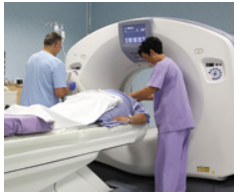
44-Year-Old Male with Skull Fracture
William Hancock, 44, fell from the scaffolding at a construction site. When emergency personnel arrived, they found him unconscious but with stable vital signs. As paramedics placed him on a backboard to stabilize his head, neck, and back, they noted watery blood leaking from his right ear. In the hospital, Mr. Hancock regained consciousness and was treated for deep lacerations on his scalp and face. Head CT scans revealed both longitudinal and transverse fractures of the right petrous temporal and sphenoid bones that extended through the foramen rotundum and foramen ovale.

The following observations were recorded on Mr. Hancock’s chart on admission:
•Complete loss of hearing in the right ear.
•Paresthesia (sensation of “pins and needles’) at the right corner of the mouth, extending to the lower lip and chin.
•Numbness of the right upper lip, lower eyelid, and cheek.
•Right eye turned slightly inward when looking straight ahead. Diplopia (double vision), particularly when looking to the right.
Mr. Hancock was given a course of antibiotics, the head of his bed was elevated by 30°. and he was placed under close observation. After 24 hours, doctors noted that the right side of Mr. Hancock’s face showed signs of drooping, with incomplete eye closure and asymmetric facial expressions.Mr. Hancock’s right eye showed minimal tear production. The weakness and asymmetry on the right side of his face began to subside after a few days, and the leak of fluid from his ear stopped, but he continued to complain of paresthesia, diplopia, and an inability to hear with his right ear.
3. Why would Mr. Hancock’s doctors give him antibiotics based on these observations? Why was the head of his bed elevated?
Want to see the full answer?
Check out a sample textbook solution
Chapter 13 Solutions
Human Anatomy & Physiology Plus Modified Mastering A&P with Pearson eText -- Access Card Package 11th edition
- Abnormal softening of the skull is known as _________________arrow_forwardWhat therapeutic procedure is described as applying a pulling force on a fractured or dislocated limb or vertebral column in order to restore normal alighnment?arrow_forwardA high-school football player died 2 days after a serious head wound received on the field during the game. He butted heads with another player hard enough to cause his skull to fracture. For a few moments, his injury did not seem serious; however, the referee ordered him off the field where he collapsed. Paramedics were called, and he was rushed to the emergency room. 1.How could such an injury be prevented? 2.As a parent or a coach, what precautions would you want to take during practices and games? 3.Identify the appropriate steps taken in this situation. ****PLEASE INCLUDE CITATIONS MLA 9TH EDITION PERDUE OWL****arrow_forward
- What is a pathologic fracturearrow_forward59 A 19-year-old college student sustained a fracture of the skull in an automobile collision. There is leakage of blood and cerebrospinal fluid from the nose. Which of the following structures is most likely to be involved? A) Cavernous sinus B) Cribriform plate of the ethmoid bone C) Nasal septum D) Orbital plate of the frontal bone E) Petrous part of the temporal bone F) Roof of the nasopharynxarrow_forwardWhy is concussion sometimes called an invisible injury?arrow_forward
- After falling off a horse, Mary complained of pain on the right side of her thorax that intensified when she took a deep breath or coughed. The emergency medical technician suspected a broken rib. Using palpation, how could the EMT identify the precise location of the injury?arrow_forwardJL, a 50-year-old woman, fell and broke the left tibia at the ankle. She is in the emergency department, waiting for the fracture to be immobilized. The leg hurts and she notes that the ankle is swelling. A diagnosis of a simple fracture and sprain (damage to ligaments) is made. What is the cause of pain and swelling? --- don't need this --- I need question #2 answered What can JL expect in the days to come as inflammation resolves and healing begins?arrow_forward14arrow_forward
- match the correct ans Column A Column B 1. Head of the humerus a.) Articulating surface at a joint 2. Foramen ovale in the skull b.) Attachment site for tendons or ligaments 3. Trochanter in the femur c.) Passageway for nerves or blood vessels 4. Costal facet in the thoracic vertebra 5. Mastoid process in the skull 6. Carotid canal in the skullarrow_forwardPatient X had a malignant duodenal tumor that was removed. The surgeon removed the whole duodenum. Predict the long-term consequences for Patient X after recoveryarrow_forwardThe patient has complained of vertigo and hearing loss. Which cranial nerve is mostly likely affected?arrow_forward
 Fundamentals of Sectional Anatomy: An Imaging App...BiologyISBN:9781133960867Author:Denise L. LazoPublisher:Cengage LearningUnderstanding Health Insurance: A Guide to Billin...Health & NutritionISBN:9781337679480Author:GREENPublisher:CengageSurgical Tech For Surgical Tech Pos CareHealth & NutritionISBN:9781337648868Author:AssociationPublisher:Cengage
Fundamentals of Sectional Anatomy: An Imaging App...BiologyISBN:9781133960867Author:Denise L. LazoPublisher:Cengage LearningUnderstanding Health Insurance: A Guide to Billin...Health & NutritionISBN:9781337679480Author:GREENPublisher:CengageSurgical Tech For Surgical Tech Pos CareHealth & NutritionISBN:9781337648868Author:AssociationPublisher:Cengage Medical Terminology for Health Professions, Spira...Health & NutritionISBN:9781305634350Author:Ann Ehrlich, Carol L. Schroeder, Laura Ehrlich, Katrina A. SchroederPublisher:Cengage Learning
Medical Terminology for Health Professions, Spira...Health & NutritionISBN:9781305634350Author:Ann Ehrlich, Carol L. Schroeder, Laura Ehrlich, Katrina A. SchroederPublisher:Cengage Learning





